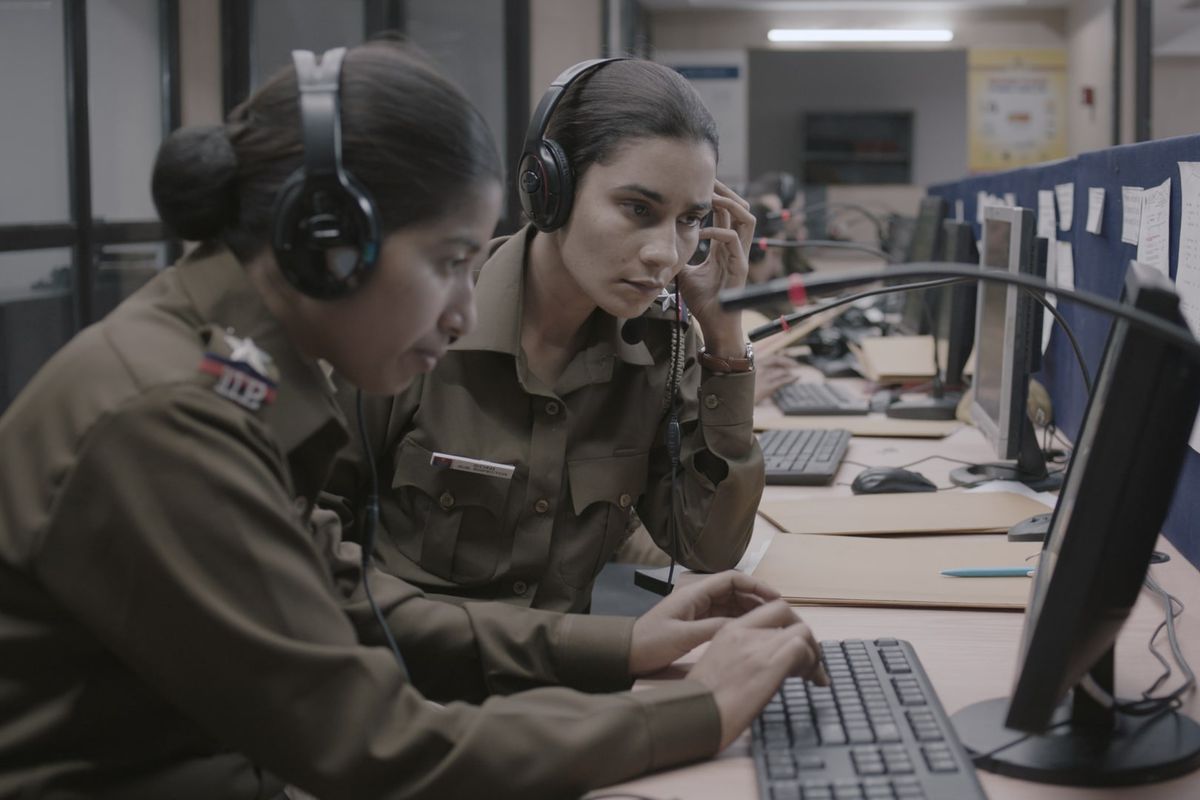Do you know what a police uniform is? It isn’t just a costume, as is commonly believed.
Look, it is “power” in the form of a costume. You want this power. Those perceived to be weak, want to possess this power at any cost.
Sure, the uniform looks good on you. Power or authority look good on everyone. But it suits one only when it is used to fight injustice. Entrusted to you to save people, it is a power that guards your self-esteem. Trust me, this uniform is a reflection of your identity.1
– Maitreyi Pushpa, Ek Fighter Ki Diary
This is a part of the series of posts, leading up to the International Women’s Day, that the Indian Cultural Forum is dedicating to women asserting change in cultural, economic, and socio-political spaces.
 Image Courtesy: Polygon
Image Courtesy: Polygon
Soni opens with an eve-teasing episode. In the late hours of the night, a man on a bicycle is harassing a woman, who then thrashes him to a pulp. Next, we learn that the woman is Sub-inspector Soni (Geetika Vidya Ohlyan). The implication is that no woman, not even a police officer is safe from sexual violence – a narrative only too familiar to every Delhi girl.
But what struck me instantly, and has stayed with me since, was the petite frame of the actor playing Soni (She’s short, but she’s got spunk!)
In the Hindi cinema tradition of melodramatic cop films, where heroes in vests or in shirtless avatars, exhibit their muscular bodies while thrashing the goondas, the image of a petite female actor playing a police officer makes for a rare sight. A cop film about gender-violence with no over-the-top fight sequences makes it all the more special. (This is an important contrast to note, especially since Soni released on Netflix on January 18, two weeks after the Rohit Shetty directorial Simmba, a rape-revenge cop drama starring Ranveer Singh was released and declared a blockbuster.)
Soni is short-tempered, easily triggered and gives an outlet to her rage by beating up harassers. In doing so, she calls for a re-thinking of the female body as a weapon, rather than as a sexual object. This image of the ‘woman in rage’ is an important one for our times, both nationally and globally.
During an interview in December 2018 (only a month before Soni’s Netflix release), the Indian Army Chief of Staff General Bipin Rawat made facetious arguments about why the Indian Army was not ready for women combat officers. He said that war situations would put women at risk and that their “homes” were not ready to have young children left behind. He also added that women officers would complain about male officers peeping through the tents when they changed their uniforms, which would cause unnecessary worry.
On the global front too, the testimonies of women fighting sexual harassment at the workplace, with the consolidation of the #MeToo Movement reveal epoch-making shifts. In her essay for The New York Times, Rebecca Traister analysed the public testimonies of Christine Blasey Ford and Brett Kavanaugh to depict, how ‘Fury is a Political Weapon’ and why women need to wield it.
The differential nature of their conduct in the court revealed the gendered nature of who gets to be angry in public. “Fury was a tool to be marshalled by men like Judge Kavanaugh in defence of his own claims to political, legal, public power,” wrote Traister. In sharp contrast, Ford’s testimony showed how fury was a weapon, never made available to women. “Female anger is discouraged, repressed, ignored, swallowed. Or transformed into something more palatable, and less recognizable as fury — something like tears”. However, the compelling testimonies by the women showed that they were now questioning this.
If not tears, the other expression associated with women’s anger has been hysteria. Look at any powerful woman in politics, particularly those who challenge male privilege and authority. You will find a cache of images of that woman snarling angrily. As Rebecca Traister notes in her book, Good and Mad: The Revolutionary Power of Women’s Anger, “The best way to discredit [these] women, is to capture an image of them screaming” because “the act of a woman opening her mouth with volume and assured force, often in complaint, is coded in our minds as ugly.” Think of Medusa, Kali, or Surpanakha, or even PM Modi’s recent comment on MP Renuka Chowdhary’s ‘hysterical’ laughter, and they will all attest to stereotypes.
In a city infamously known as the ‘rape capital of the world’, when a woman dons a police uniform, it is a political statement. A Hindi film with a woman police officer as the protagonist, which is streaming on a global platform like Netflix, becomes a participant in a movement.
Ivan Ayr’s Soni promises that things are changing. Geetika/Soni is the sole presence in most posters of the film. The Netflix poster is a watercolour marked face of Geetika in an agitated moment. Her lips are pressed together. She is neither unhinged, hysterical, nor screaming. It is a portrait of a woman’s simmering rage. As we learn through the film, her rage is not born out of a singular personal experience but is directed towards patriarchy on the whole. This image is refreshing and awakening, terrifying and exhausting, necessary and freeing. If she were not shown in a uniform, she could be Every Woman. This ‘relatability’ is a progressive development in the representations of ‘angry women’ in mainstream media. It tells you that “angry women, once considered alienating, are now considered relatable.” 
Image Courtesy: Wikipedia
This design of the Everywoman mirrors the film’s form. From the very first scene of harassment, to solving (fake) rape cases, to opposing the moral-policing of young lovers, and standing up to power-drunk navy officers, Ayr establishes that every act of extraordinary violence derives from the registers of the ordinary. Particularly in the scene where Nishu, confesses that she wanted to murder all the boys in her class who made fun of her period, the film emphasises that all women – in the streets, the polls, our homes, and even in fiction – are angry and unapologetic about it. It foregrounds that women’s anger has become more than an emotion — it’s become a mass movement.
Though the title denotes an individual, Soni departs from the indulgence of a first-person narrative. It is the story of Superintendent of Police Kalpana (Saloni Batra) and Sub-inspector Soni (Geetika Vidya Ohlyan) who are fixing toxic masculinity in law enforcement, one case at a time. The film is gloriously carried on the shoulders of the lead actors through their fresh, earnest, and meticulous performances. In what hardly seems like a debut, Ayr captures the “human essence” of women-characters, employed in a ‘masculine’ occupation like the police department, where even female superior officers are addressed as “Sir”.
They are like yin-yang. Soni is short-tempered and volatile. Kalpana is patient and empathetic, with a maternal touch. The cinematography accentuates this contrast throughout the film. Kalpana’s house and happy marital life are warmly lit within wide frames, signifying stability and wealth. Every scene between Soni and her husband shot in her cold, dingy apartment is awkward and claustrophobic.
There is an obvious class angle. Kalpana’s husband is a top government official. She has in-laws, nieces, and domestic help who constitute enormous social capital. Even though the titular character is Soni, we know more about Kalpana, because she is the wife, daughter, aunt, or boss we all want.
Soni, on the other hand, is divested of a background story or history. We don’t know where she comes from. We can guess that she is a migrant, because her nosy neighbour who makes for a typical agony-aunt-like-Delhi-character, is the only one who enquires about her well-being. She is the only one who points to the lack of social support systems in Soni’s life. “Put some vermillion in your hair when you step out,” she advises her. That’s how we come to know about Soni’s marital status.
Her house is unkept. Her work-life balance is skewed. If Soni forgets to buy milk or leaves it out overnight, she is going to have to leave for work without tea in the morning. These are harsh realities of her life- something that Kalpana will never have to worry about. We can see why Soni is always angry, angsty, or frustrated. She is not a “nice woman” because she cannot afford to be! These details not only position Soni and Kalpana at different stages in the women’s movement but also highlight the inherent contradictions in Delhi as an urbane city.
Perhaps the absence of a soppy background story is to ensure that the viewer doesn’t too readily sympathise with the character. This is usually an evolved directorial sensibility. However, there is a difference between distancing and producing an alienating effect. Sadly, Ayr’s filmmaking gets complacent doing the former.
I say this also because the treatment of the minor characters sometimes reveals more about the director’s “intent” than the recognizable central characters. In Soni, if the heroes are women, the villains are unambiguously men. Yes, representation matters, but when a film replicates the same traditional paradigms to diminish one or the other, we need to ask if it is in fact, radically pushing the dialogue? The lechers are all stock Delhi characters, so are the misogynistic police. Soni’s husband is fickle and weak. Kalpana’s spouse is stubborn and condescending. That all this is only too clear to me is when my suspicions arise. Soni is too clear, too safe, and too good to be true. Through this reductivity of “right” and “wrong”, the film begins to look “less realistic and more programmatic”, as Sreehari Nair writes in his review of Soni. He rightly points out that the majority of the film is shot in a documentary-style, which only further confirms the audience’s pre-existing bias about demons and saviours in our world. Ayr works tirelessly to give the film “the appearance of unvarnished truth. Nair finds this “cunning documentary” mode “morally offensive.”
Nair is right. Given the ecosystem in which subjects are chosen and films are now produced, distributed, and watched, it was not surprising that soon after its MAMI premiere Soni was acquired by Netflix. Due to today’s global gender dialogue, the film has won national and international acclaim at several film festivals including the Oxfam Gender Award. Thus, more than being an agent of change, Soni is clearly a product of its times.
By that logic, does it even make a difference that a film like Soni was made?
The answer lies in the film itself. In a moving scene, Kalpana gifts Soni a copy of Amrita Pritam’s Raseedi Ticket and narrates the story behind the title. After reading Pritam’s manuscript, a man had remarked that there was nothing new or special about the story that was deserving of the investment of a whole book to itself. Giving her story the place of a whole book was giving it too much importance.
For him, her story was so trifling, that it could to fit on the back of a ‘passenger stamp’. The essence of Soni and women’s stories, on the whole, lies therein; Soni stands for Everywoman.
2 I understand that the term “relatable” evokes eye-rolling among some critics, but I use it as a functional term to describe one of the chief effects that Soni intends to create: that its audiences, especially the women are able to see themselves through the characters; and through seeing, transform themselves, and their future.
Read More:
Aurat : What it means to be a working-class woman in India
Is Uri the Border of the twenty-first century?




